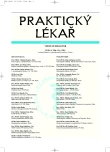Hypoglycaemia-associated autonomic failure, its clinical assessment and treatment.
Authors:
M. Mindlová; F. Saudek
Authors‘ workplace:
Ředitel: MUDr. Štefan Vítko, CSc.
; Institut klinické a experimentální medicíny, Praha
; Přednosta: Doc. MUDr. František SAUDEK, DrSc.
; Klinika diabetologie, Praha
; Přednosta: prof. MUDr. Terezie Pelikánová, DrSc.
; Centrum diabetologie, Praha
Published in:
Prakt. Lék. 2007; 87(1): 52-57
Category:
Therapy
Overview
Hypoglycaemia is the most frequent complication of insulin therapy in diabetic patients. Severe hypoglycaemia may impair not only the brain, but also the heart and autonomic nervous system. Frequent episodes cause a failure of the autonomic nervous response to a falling blood glucose level and also impair its counter regulation. The changes caused by repetitive hypoglycaemia deepen the autonomic failure and lead to more and more frequent episodes. This phenomenon has been called „hypoglycaemia-associated autonomic failure (HAAF)”. Its pathophysiological mechanisms have been described but there is still a need for its clinical assessment. The exact evaluation of the frequency and seriousness of hypoglycaemia, as well as the autonomic nervous impairment, is essential for the selection of further treatment procedures. For this reason a scoring system has been developed. Transplantation of either the islet of Langerhans or pancreas has been proven to be the best treatment of HAAF. Afunctioning graft ensures long-term euglycaemia or at least improves unstable glycaemia. The fundamental prerequisite for HAAF treatment is several weeks without hypoglycaemia.
Key words:
hypoglycaemia, diabetes mellitus, autonomic nervous system, transplantation
Labels
General practitioner for children and adolescents General practitioner for adultsArticle was published in
General Practitioner

2007 Issue 1
Most read in this issue
- Chronic renal failure in primary care
- Craniopharyngioma in 79 years old man – a case study
- Wilson’s disease
- Hypoglycaemia-associated autonomic failure, its clinical assessment and treatment.
